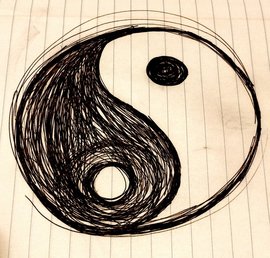This Yogic Universe: Duality and Uncertainty in Physics and Our Lives.
I’m often struck by similarities between the Yogic world and the scientific world: the rules of one often apply to the rules of the other.
Take duality, for instance. Yogic texts describe the material world as dualistic, which few will deny. Our world manifests itself as a variety of spectrums with two extremes: light and dark, good and evil, delicious and disgusting, calm and anxious, fast and slow. We live within these contexts and often suffer from them.
Our senses lead us to develop aversions or desires for one dualistic extreme or the other, which can often lead to destructive and painful thoughts or emotions. For example, the stress we feel at work can arise from a desire for material wealth and comfort. Or, the impatience we feel when in traffic can arise from an aversion to wasting time. Anger, which often boils up when we’ve been hurt, can arise from the desire to be accepted by everyone.
Whether the spectrum is material, social, or temporal, we are often driven by one extreme or the other if we’re not conscious of it. In either case, these desires and fears can drive us to extreme circumstances and feelings, which can derail our flow and shatter our contentment.
The life of Buddha, known as Gautama in a variety of biographies, teaches the middle path, one of moderation between extremes. In Gautama’s case, he lived for a time with extreme indulgence as a royal prince and later with extreme asceticism as a monk. It was after these experiences that he realized the foolishness of these polar opposite lifestyles: in pursuing our strongest desires or fleeing our strongest aversions, we relinquish our own agency and in a way become the hamster on the wheel.
In our attempts to satisfy our desires and flee our aversions, we become imprisoned. Buddha saw this, and chose the middle way, surrendering in the fight for desire and the flight from fear. Instead, through turning inward Buddha found freedom and Enlightenment. So the story goes ...
There is another story, found in the mathematic fabric of our universe, which relates elegantly to the Yogic story of Buddha and duality: the Uncertainty Principle. This mathematical and physical characteristic of the universe was discovered in 1927, but it has been true since the origin of the cosmos. In a nutshell, this principle describes the universal truth that you can only know so much about anything.
Imagine you are in a room by yourself, holding Utkatasana (chair pose). Now imagine you are in a room with a group of people observing you hold this pose. Social psychology studies by Hazel Markus in 1978 revealed that we often perform better or worse (depending how complicated the task) when we are being observed. Since the very act of observation influences the subject being observed, there is always some uncertainty in our psychological studies.
Cloud Chamber
This same principle applies to the building blocks of the universe. At its most reduced scale, such as that of the electron, the act of measurement influences the subject, thus rendering the measurement inaccurate. When we try to measure the location of a particle, we influence its speed...and when we try to measure its speed, we influence its location. Like a seesaw, as our knowledge in one dimension increases, our knowledge in another dimension decreases. In fact, to truly know *everything* about anything is physically impossible!
You might notice that this observer-observed phenomenon echoes of the Vedic Purusha and Prakriti (also described in Patanjali’s sutras). Purusha and Prakriti are, respectively, the primordial ‘Observer’ (‘consciousness’, ‘Universal Consciousness’, or ‘Buddhi’) and the ‘Observed’ (‘Nature’, ‘matter’, ‘Maya’). Besides this parallel in the Vedic origin story, the idea that we can never be certain of anything renders the pursuit of ideals comical. In this modern world we can forget this fact and become staunch and closed minded in our opinions and our goals. Yet, nothing is ever guaranteed in this universe.
This can be remembered as we race towards success or away from failure. There can be no ‘complete’ success, as there can be no ‘complete’ failure. The pursuit of the extremes leads not to the answer, but to more unknown--it is the endless pursuit, which is suffering.
By following the middle path, be it easing the foot off the pedal when feeling rushed, cracking a smile when feeling depressed, giving a dollar to someone on the street when feeling skeptical, we can break a cycle of suffering. Remember, the physical universe in all its forms, whether material or emotional, societal or personal, is never completely certain. Like Shiva and Shakti, the universe is both of form and formless. By moving away from the extremes, by living with the limited certainty we have and embracing the uncertainty, we can follow the middle path and find liberation.
I met Kula's Coby and Ananda on a surf trip to Troncones. They held my first cacao ceremony, but not my last. I returned to my job in San Francisco, but later after quitting, I'd meet back up with them in Peru for more ceremony. I help the Kula market their life-changing trainings and retreats - it's a perfect way to promote openness in the world and follow my internal compass towards the nomadic life.





